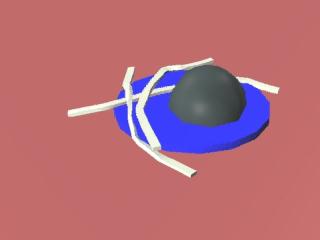 technology
technology
|
Falling Bodies technology notesNEW: We take the Noodle Challenge.
Each noodle is a six-element articulated IK chain enveloped with a Softimage flexible skin, simulated with Falling Bodies Two. This is a rigid-body simulation, but the smooth skin makes it look more flexible than it really is. Each joint is a 3 degree of freedom joint, allowed +- 30 degrees of rotation in each axis. This allows some bend and twist, but not too much. Does it fall like a noodle? Tell us what you think. Anybody have a good 3D model of a fork? We want to try picking
up a noodle with it.
How we do dynamics - a short note for expertsFalling Bodies is a spring/damper simulator using a reduced degree of freedom model to create a set of ordinary differential equations, which are then integrated forward using both explicit and implicit integrators. Joints are handled by the reduced degree of freedom model using generalized coordinates. Collisions are modeled as exponential springs. Some new techniques, covered by a pending U.S. patent, allow Falling Bodies to deal effectively and reliably with the very stiff numerical systems that result from this formulation. Collision detection is based on convex polyhedra, with a distance measure using the GJK algorithm front-ended by an axis-oriented bounding box system. Most other simulators for animation and games use an impulse/constraint approach. It's inherent in the impulse/constraint approach that collisions result in instantaneous changes in direction and velocity. That looks subtly wrong; light and heavy objects bounce the same way, and the viewer doesn't get the impression of weight when a heavy object hits. We call this the "boink problem". Our approach, using nonlinear springs to simulate collisions, provides a more accurate simulation; heavy and light objects bounce differently. This, incidentally, is why Falling Bodies is slower than some of the competitive products. Now that 1GHz PCs are shipping, this is much less of a problem than it used to be. Research and developmentControl of Legged LocomotionOnce they can fall down, the next step is making them smart enough not to. This is the hard road to realistic character motion.
Other |
Last updated June 1, 2001
